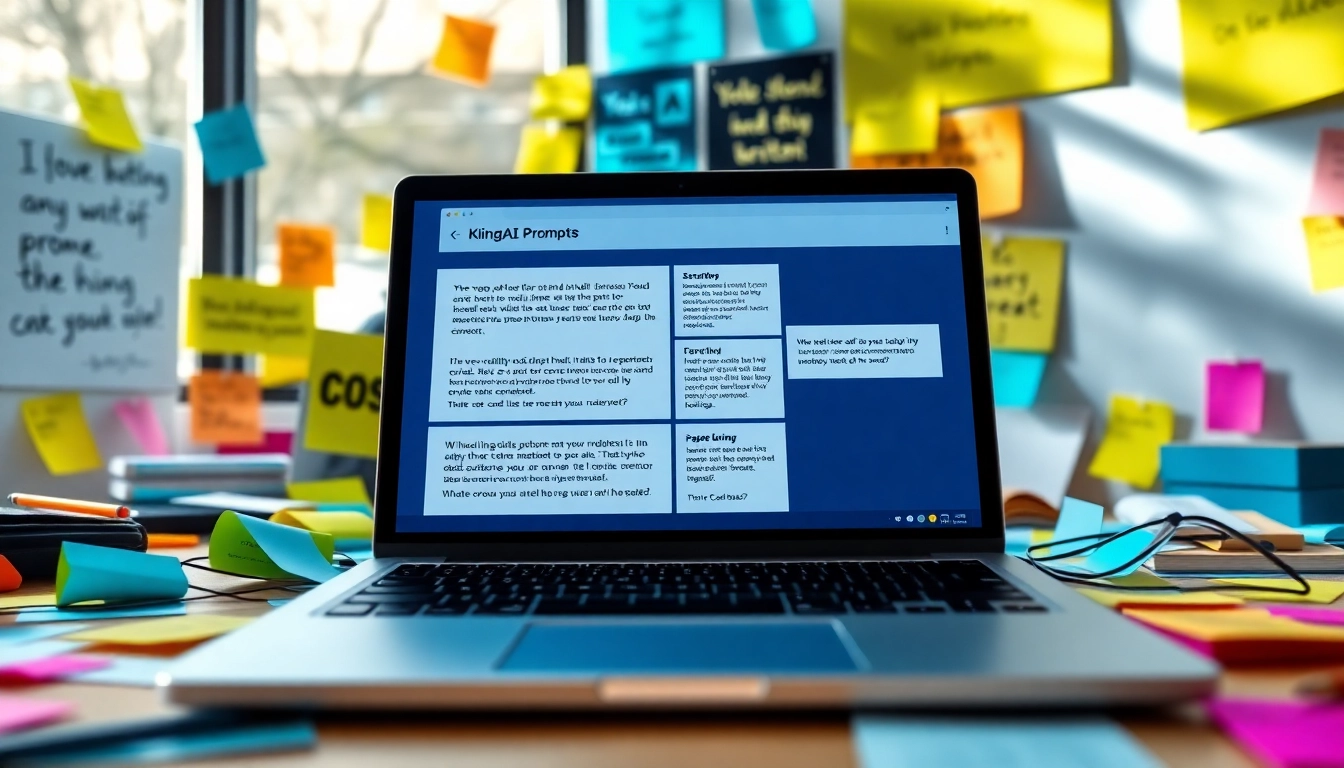Understanding KlingAI Prompts
What are KlingAI Prompts?
KlingAI Prompts serve as powerful textual commands that guide AI systems in generating visual content, particularly videos. They provide specific instructions regarding scene elements, character actions, and emotional tones, training the AI to interpret human language into engaging, compelling video narratives. As a tool for content creators, they bridge the gap between imaginative storytelling and technical implementation, turning ideas into visual reality without the need for extensive video production skills.
By leveraging KlingAI Prompts, users can generate high-quality videos that are not only visually appealing but also aligned with their storytelling objectives. This AI-driven approach democratizes video content creation, enabling anyone, regardless of technical expertise, to bring their concepts to life through engaging imagery and motion.
The Importance of Structure
Effective KlingAI Prompts adhere to a structured format, which enhances clarity and precision in the resulting visual output. A well-structured prompt typically includes a blend of descriptive language, context-setting details, and specific instructions that can guide the AI in rendering scenes accurately. The importance of this structure cannot be overstated; it determines the extent to which the AI can comprehend and fulfill the creative vision of the user.
Examples of effective prompt structure may include:
- Descriptive adjectives to elaborate on the visuals (e.g., “a vast, sunlit meadow”)
- Action verbs to dictate movements or changes (e.g., “a fox dashes across the field”)
- Emotional context to evoke feelings (e.g., “set in a serene, peaceful environment”)
This complexity fosters a richer output, allowing the AI to generate nuanced, dynamic videos that resonate with viewers.
Common Types of Prompts
KlingAI Prompts can be categorized based on their intended outcomes and the type of content they inspire. Some common types include:
- Descriptive prompts: These provide elaborate details about what the video should depict. For example, “a bustling cityscape in the rain at dusk” gives both a setting and atmospheric context.
- Action prompts: These directly suggest actions for characters or scenes, such as “a child leaps joyfully on a trampoline,” guiding the AI to animate movement.
- Emotion-driven prompts: These set an emotional tone, often using phrases like “a bittersweet moment of reunion,” which can influence the mood of the visuals.
- Contextual prompts: These outlines broader contexts, such as “during a summer festival,” providing the AI with background details that enhance storytelling.
Best Practices for Creating KlingAI Prompts
Techniques for Engaging Content
To craft compelling KlingAI Prompts, content creators should focus on several best practices. Engaging content hinges not only on what is said but also on how it is presented. Above all, the prompt should inspire the AI to create a captivating narrative.
Here are several effective techniques for generating engaging content through KlingAI Prompts:
- Utilize Echo Words: These are words that evoke a strong image or sound. By strategically including echo words, creators can enhance visual representation. For instance, using “crash” in conjunction with “waves” creates vivid beach imagery.
- Provide Clear Context: Contextual cues ensure the AI understands the narrative situation. Clearly defined timelines or backstory elements can help elucidate the scene for more relatable content.
- Encourage Multi-Sensory Engagement: Encouraging the AI to incorporate sound, movement, and visual elements will enhance the audience’s experience. Phrases that invoke sensory details can make video content more immersive.
Using Descriptive Language
The language of KlingAI Prompts should be vividly descriptive. Utilizing adjectives and adverbs can paint a clearer picture for the AI. For example, instead of simply stating “a car drives,” one could say “a sleek, red sports car accelerates along a winding mountain road.” This level of detail encourages the AI to produce a more vibrant and dynamic video output.
Moreover, descriptive language should appeal to various senses, allowing the viewer to visualize sights, sounds, and even feelings associated with the scene. Paint a picture in words, as the clearer the vision, the sharper the execution by the AI.
Incorporating Visual Elements
Effective KlingAI Prompts often include specific visual elements that guide the AI in creating scenes. Detailing colors, textures, lighting, and even the arrangement of objects can significantly influence the final output.
Consider the impact of visual elements:
- Color Schemes: Color can evoke emotions and set the mood for a scene. Describing a “dazzling sunset with oranges and purples” can inspire the AI to mirror this beauty.
- Textures: Including textures adds depth. Phrases such as “the rough surface of a cobblestone street” provide detail that enhances visual realism.
- Lighting: Specific calls for lighting, such as “soft morning light filtering through trees,” can alter the scene’s atmosphere drastically, guiding emotional impact.
Advanced Strategies for KlingAI Prompts
Leveraging Contextual Awareness
A deeper understanding of context can significantly enhance KlingAI Prompts’ effectiveness. Contextual awareness means recognizing the relational dynamics within the visuals and the information imparted through prompts. Structured prompts should convey not only the action but the intricacies of character relationships and situational cues.
For example, a prompt like “a mother comforts her son after he loses a game” lays groundwork for emotional engagement by depicting a familial bond and reaction to failure. This strategy fosters more relatable and engaging narratives.
Utilizing Feedback Loops
Feedback loops are crucial in the process of refining KlingAI Prompts. By analyzing the outputs generated by the AI, creators can assess what works well and what requires adjustment. This iterative process allows for continuous improvement and parameter tweaking, ensuring that the resulting videos are aligned with the desired narratives.
To effectively implement feedback loops, consider:
- Reviewing the outputs critically: Identify strengths and weaknesses in the generated videos.
- Making adjustments: Based on the review, refine prompt wording or structure, emphasizing the aspects that need enhancement.
- Testing variations: Experiment with slight alterations in prompts to see how they impact the outcomes.
This dynamic approach ensures that creators remain flexible and responsive to the capabilities of the AI.
Experimenting with Variations
In writing KlingAI Prompts, experimentation plays a vital role in discerning what elicits the best results. Creating multiple variations of a prompt allows creators to test different scenarios, character interactions, and emotional tones. This variability ensures a wider range of interpretations and can help discover novel inputs that produce unexpected yet compelling outputs.
For example, rather than stating “a cat sits on a windowsill,” one might create variations such as “a sleepy cat lounges on a sunlit windowsill” or “a curious cat peeks out from behind a curtain,” each eliciting distinct visual narratives.
This experimentation encourages creativity and exploration, allowing the user to maximize the potential of KlingAI Prompts.
Troubleshooting Common Issues with KlingAI Prompts
Identifying Unsuccessful Prompts
Despite careful crafting, some KlingAI Prompts may generate unsatisfactory outputs. An essential part of troubleshooting involves identifying these unsuccessful prompts promptly. Signs of a poor prompt include:
- Vague or unclear instructions that the AI misinterprets
- Outputs that deviate significantly from the intended message or emotion
- Visual narratives lacking coherence or context
Recognizing these issues early allows creators to refine their prompt-building strategies.
Refining Your Approach
Upon identifying ineffective prompts, creators should implement refinements to improve the overall quality of KlingAI outputs. This refinement can take several forms:
- Clarifying instructions: Ensure that the prompt is explicit and concise.
- Adding context: Include more background information to facilitate better AI understanding.
- Using varied vocabulary: Experimenting with synonyms and alternative phrasing may yield improved results.
Continual refinement of prompts will enhance the quality of the generated content over time.
Learning from Community Feedback
Engaging with a community of KlingAI users can provide valuable insights into prompt crafting. Sharing experiences and outcomes allows for collective learning, where users can discuss what has worked effectively or what challenges they have faced.
Active participation in forums, social media groups, and creative platforms can spark new ideas and tactics for crafting better KlingAI Prompts. This collaborative approach encourages a culture of sharing knowledge and creativity, leading to improved overall content creation.
Measuring Success with KlingAI Prompts
Key Metrics to Track
When evaluating the effectiveness of KlingAI Prompts, it’s essential to track key performance metrics. Metrics such as viewer engagement rates, shares, comments, and watch time provide valuable insights into how well the content resonates with its intended audience.
Depending on the project’s goals, some specific metrics to consider include:
- Engagement Rate: Identifying how viewers interact with the video content.
- Shares: Assessing the level of distribution and peer recommendation.
- Watch Time: Measuring how long viewers stay engaged with the video.
These metrics collectively inform creators whether their KlingAI Prompts are successfully generating engaging and effective video content.
Evaluating Engagement and Effectiveness
Once key metrics are identified, evaluating engagement and effectiveness becomes paramount. This evaluation can ascertain whether the KlingAI output aligns with the creator’s original intent and audience expectations.
Consider conducting surveys or user feedback sessions to gather qualitative data that may enrich the understanding of viewer experiences. Qualitative insights, combined with quantitative metrics, provide a holistic overview of success and areas for enhancement.
Adjusting Strategies Based on Results
The information gleaned from tracking metrics and gathering feedback should directly inform future prompting strategies. An adaptive approach ensures continual growth and improvement, enabling creators to refine their techniques for even better results.
Strategies may include:
- Adapting prompt language: Modify phrasing based on audience preferences.
- Experimenting with new content styles: Consider diversifying the type of projects undertaken to reach broader audiences.
- Incorporating user feedback: Integrate constructive criticism to shape future content.
This iterative process helps content creators to hone their craft effectively, ultimately resulting in a more engaging series of KlingAI Prompts.



